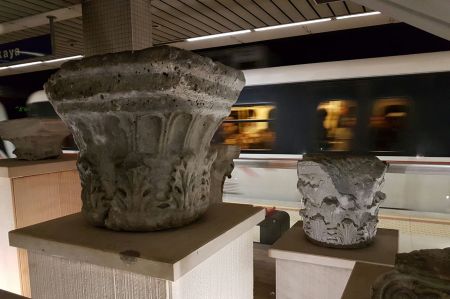Metro Izmir - ancient artifacts in Çankaya
- Written by Portal Editor
Whoever has been driving through Izmir in certain years has certainly noticed the worsening traffic conditions in the growing Aegean metropolis. Since the beginning of the 1980s individual traffic on İzmir's roads has increased steadily.
The urban bus system alone was no longer able to ensure the mobility of the city.
For a long time there was the idea and plans of a subway, finally the construction works of the İzmir Metro began on 18th of May 1995 on only one line and also limited to the city core. This route was 20 km long and had 17 stations. The journey on the route, which runs underground, on a viaduct and in a valley incision, today takes about 25 minutes. Thus, the metro begins south-west of the center of İzmir at Hatay station and runs north-east through the inner city of Konak, below the boulevard İnönü Caddesi. In Basmane, the metro leaves the tunnel and continues up to Bölge. Halkpınar - one of İzmir railway stations, which is connected to İzban train station - and the Stadyum station at the sports stadium, will follow the route. In Bornova, the underground runs past the Ege University to Evka. Further stations follow continuously.
When setting up and expanding the metro routes, priority was given to the fact that the bus network is to be replaced or supplemented by the construction of rail-bound high-speed lines, because the metro clearly has a higher transport capacity.
Of particular importance here were some tunnel sections, as well as the Ümmühan twin tunnel, which connects the stations Konak, Çankaya and Basmane. The groundwater, which is already at a depth of 1.5 m, was particularly challenging in this section, as the tunnels and stations are below sea level. Since this section contains ancient buildings (Agora) and eight-storey buildings as well as a narrow curve with a radius of 250 m, this tunnel section was created with the special EPBM tunneling method. On 25 August 1997, the drilling work began with a tunnel drilling machine from Basmane in the direction of Konak.
Izmir, the ancient Smyrna, was an immensely influential city during the Roman era, next to Efesus as a metropolis. Whoever has been to Agora will be able to confirm this impression. The remaining buildings of the former city center are still looking so powerful. And still some of the then-created canals for the supply and disposal of the city water system work flawlessly.
It is no wonder, then, that during the construction work intermittent interruptions took place, in order to recover artifacts from the ancient world. Some of these finds are now exhibited at the Çankaya subway station.
Please read as well:
Archaeologists discover a late Roman barroom in Ephesos
The clock tower - Izmirs landmark at Konak
-
 Roman Artefacts found during Metro Construction
Roman Artefacts found during Metro Construction
Roman Artefacts found during Metro Construction
Roman Artefacts found during Metro Construction
-
 Roman Artefacts found during Metro Construction
Roman Artefacts found during Metro Construction
Roman Artefacts found during Metro Construction
Roman Artefacts found during Metro Construction
-
 Roman Artefacts found during Metro Construction
Roman Artefacts found during Metro Construction
Roman Artefacts found during Metro Construction
Roman Artefacts found during Metro Construction
-
 Roman Artefacts found during Metro Construction
Roman Artefacts found during Metro Construction
Roman Artefacts found during Metro Construction
Roman Artefacts found during Metro Construction
-
 Roman Artefacts found during Metro Construction
Roman Artefacts found during Metro Construction
Roman Artefacts found during Metro Construction
Roman Artefacts found during Metro Construction
-
 Roman Artefacts found during Metro Construction
Roman Artefacts found during Metro Construction
Roman Artefacts found during Metro Construction
Roman Artefacts found during Metro Construction
https://www.alaturka.info/en/turkey-country/aegean/izmir/3636-metro-izmir-ancient-artifacts-in-the-station-cankaya#sigProId9a7dbea4dc

